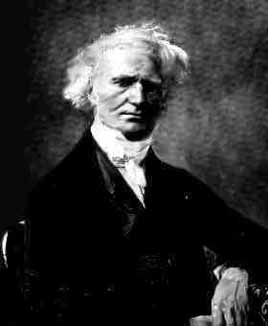
Jacques Philippe Marie Binet
 المؤلف:
I Grattan-Guinness
المؤلف:
I Grattan-Guinness
 المصدر:
Convolutions in French Mathematics, 1800-1830
المصدر:
Convolutions in French Mathematics, 1800-1830
 الجزء والصفحة:
...
الجزء والصفحة:
...
 13-7-2016
13-7-2016
 1332
1332
Born: 2 February 1786 in Rennes, Bretagne, France
Died: 12 May 1856 in Paris, France

Jacques Binet entered the École Polytechnique in Paris on 22 November 1804 and, after graduating in 1806, he worked for the Department of Bridges and Roads of the French government.
He became a teacher at École Polytechnique in 1807 and, one year later, he was appointed to assist the professor of applied analysis and descriptive geometry. In 1814 he was appointed examiner of descriptive geometry then, in 1815, he was appointed to succeed Poisson in mechanics.
In 1816 not only did Binet become an inspector of studies at l'École Polytechnique but he also became an editor of the edition of Lagrange's Mécanique analytique that was being prepared two years after Lagrange died. Binet was also appointed to the chair of astronomy at the Collège de France in 1823.
However the revolution of July 1830 was unfortunate for Binet. The revolution started after Charles X published restrictive ordinances on 26 July which were contrary to the spirit of the Charter of 1814. There were protests, demonstrations and fighting on July 27, 28 and 29. Binet was a strong supporter of Charles X so it was bad news for him when Charles X abdicated on August 2 and, a week later, Louis-Philippe was proclaimed King of France. Binet was far too much associated with the previous regime to be acceptable to that of Louis-Philippe and he was dismissed as inspector of studies on 13 November 1830.
Binet investigated the foundations of matrix theory which was to set the scene for later work by Cayley and others. He discovered the rule for multiplying matrices in 1812 and it is almost certainly for this that he will be remembered rather than his other work.
He did, however, write a number of important papers which were influential in the development of mathematics, in particular he wrote Mémoire sur les intégrales définies eulériennes in 1840. The following year he wrote on number theory, making a contribution to the theory of the Euclidean algorithm. This particular piece of work is discussed in [2] where Shallit writes:-
Binet's analysis [of the algorithm] is surprisingly modern in presentation.
Binet wrote on topics other than mathematics. His other contributions were in the fields of physics and astronomy, and since he held the chair of astronomy at the Collège de France for over 30 years this is not surprising. In all he wrote over 50 papers.
Among the many honours which Binet received for his work was Chevalier de la Légion d'Honneur on 1 May 1821 and election to the Académie des Sciences in 1843.
Books:
- I Grattan-Guinness, Convolutions in French Mathematics, 1800-1830 (Basel, 1990).
Articles:
- J Shallit, Analysis of the Euclidean Algorithm, Historia Mathematica 21 (1994), 401-419.
 الاكثر قراءة في 1780to1799
الاكثر قراءة في 1780to1799
 اخر الاخبار
اخر الاخبار
اخبار العتبة العباسية المقدسة


